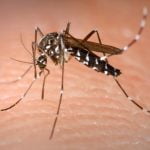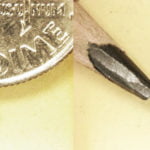Mosquitoes of the Florida Keys

Black Salt Marsh Mosquito
The Black Salt Marsh Mosquito (Aedes taeniorhynchus) is the most common mosquito in the Florida Keys. This mosquito is an aggressive biter that creates havoc during outdoor activities, especially at dawn and dusk. The Black Salt Marsh mosquito is a migrating mosquito that is often seen moving into the Florida Keys from the Everglades during “blow-ins”, as well as from uninhabited offshore islands.
Black Salt Marsh mosquito larvae are found in fresh and brackish water pools near salt marshes. The adults are fierce biters and strong fliers. These mosquitoes are controlled mainly by aerial adulticiding and larviciding.

Aedes aegypti
Aedes aegypti, commonly called the Dengue or Yellow Fever Mosquito, is the most common container breeding mosquito in the Florida Keys (especially in Key West).
Commonly associated with people and homes, the Aedes aegypti is found breeding in artificial containers like trash cans, flower pots, buckets, coolers, children’s toys, birdbaths, etc. The best way to eliminate this mosquito is to dump water around your home and eliminate places for water to collect after a rain event.
This mosquito is a vector for several diseases such as Zika, Dengue, Chikungunya, Yellow Fever and many others.

Southern House Mosquito
Culex quinquefasciatus, commonly known as the Southern House Mosquito, is a medium-sized brown mosquito that is found in the southern United States and is present in the Florida Keys.
This nighttime-active, opportunistic blood feeder is a vector of many of pathogens, several of which affect humans. Throughout much of the southern U.S., Cx. quinquefasciatus is the primary vector of St. Louis Encephalitis virus (SLEv) and can transmit West Nile virus.
These mosquitoes are a container breeder and can be found anywhere from storm drains to tire piles.

Mosquito Biology
All mosquitoes require standing water or moist soil to breed, but the type of water they prefer depends on the species. Some prefer containers, such as tires, tree holes, buckets, and water troughs. Others prefer water with lots of organic material (leaves, grass) that is very stagnant. Still others breed primarily in swamps and marshes, some fresh water, and some salt water.
Female mosquitoes bite humans and/or animals, using the blood as a protein source to develop her eggs. The eggs are laid in or near water, hatch (some require flooding while others hatch immediately), and begin larval and pupal development. Development from egg to adult can be completed in as little as 6-7 days in the summer.
The egg to larva to pupa to adult life cycle of the mosquito is called complete metamorphosis and is similar to the life cycle of a butterfly.
Some species will bite almost any type of animal, while others are very specific. Different species vary in their preferred time to feed, but many feed during dawn or dusk.

No-See-Ums (Biting Midges)
Biting midges can be a nuisance to campers, fishermen, hunters, hikers, gardeners, and others who spend time outdoors during early morning and evenings, and even during the daytime on cloudy days when winds are calm. They will readily bite humans; the bites are irritating, painful, and can cause long-lasting painful lesions for some people.
A common observation upon experiencing a bite from this insect is that something is biting, but the person suffering cannot see what it is. Biting midges are sometimes incorrectly referred to as sand flies. Sand flies are insects that belong to a different biological group and should not be confused with the biting midges.
In the tropics, the larval habitat of many species is in rotting fruit, bromeliads, and other water-holding plants. Other larval habitats include mud, sand, and debris at edges of ponds, lakes and springs, tree holes, and slime-covered bark. The larval stage can last from two weeks to a year, depending on the species, temperatures, and geographic area.
Historically, management methods included diking and drainage of marshlands to reduce the habitats used by the immature stages. The insecticide DDT was used to target the adult stage. Currently, larval habitats are not targeted in control efforts because of the extensive amount of area that the habitats may cover, some negative environmental impacts resulting from changing water flow patterns of large areas, and the spotty spatial distribution of larvae within a given habitat.
Applications of insecticides targeting the adult stage are not efficient. While this type of application may kill biting midges active on a given night, they are continually dispersing from the larval habitat and entering areas of human activity. It would require insecticide applications on a daily basis in some areas, and this is not efficient or environmentally sound. Many government agencies that provide mosquito control services receive complaint calls about biting midges. However, most of the programs are not mandated or allowed to respond by providing control measures.
Homeowners can install proper screening for windows and patios to prevent no-see-ums from entering residences and outdoor areas used for leisure and entertaining. Most biting midges can pass through 16-mesh insect wire screen and netting, so a smaller mesh size is required. The small mesh size does limit air flow through the screens. Additionally, because no-see-ums are so small and are weak fliers, ceiling and window fans can be used at high speeds to keep no-see-ums out of small areas.
Repellents containing DEET (N,N-diethyl-meta-toluamide) typically used as mosquito repellents are also labeled for use against no-see-ums and can be applied prior to exposure to the biting midges. It is important that the directions for application that are printed on the label are followed for any product used as a repellent.
*Information found at http://entnemdept.ufl.edu/creatures/aquatic/biting_midges.htm